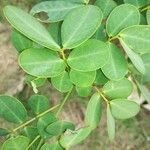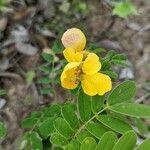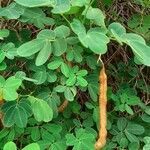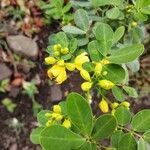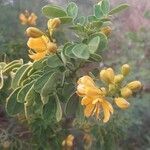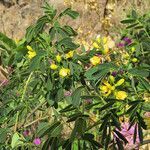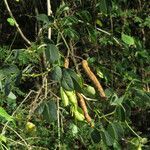Shrub 1-5 m tall. Branchlets olive, becoming grey, glabrous, longitudinally ridged. Leaves paripinnate; stipules c. 2 mm long, very narrowly triangular, early-caducous; petiole 0.6-2.3 cm long, glabrous; rachis 1-2.5 cm long, glabrous except for a patch of minute probably glandular hairs between each leaflet pair, with an ellipsoid gland c. 1 mm long between the proximal leaflet pair; leaflets in 3-4 pairs, 1.5-4 x 1.2-2 cm, the distal largest, broadly elliptic to broadly obovate or subcircular, base rounded to cuneate, slightly asymmetric, apex acute to rounded or retuse, often minutely mucronate, glabrous; petiolules c. 1 mm long. Inflorescences axillary, racemose; bracts 1-2 mm long, very narrowly triangular, early caducous; pedicels 4-5 mm long at anthesis. Sepals 5, elliptic, dimorphic, two c. 10 x 5 mm, three 5-7 x 3-4 mm, glabrous. Petals yellow, 12-14 x 6 mm, obovate. Stamens 9, trimorphic, two fertile with anthers c. 7 mm long and filaments c. 8 mm long, four fertile with anthers c. 5 mm long and filaments c. 1 mm long; three trumpet-shaped staminodes c. 4 mm long. Ovary c. 10 mm long, glabrous; style 4 mm long, glabrous. Pod 8-15 x 1-1.5 cm, oblong-linear, straight, cylindrical, rounded at apex, tardily dehiscent along both sutures, or indehiscent. Seeds olive-brown, 5-6 x 3.5-4.5 mm, broadly elliptic, without areoles.
Arborescent shrub up to 3 m high, spreading with pendant or sometimes climbing twigs, entirely glabrous except for the young branches which may be thinly pubescent. Stipules narrowly lanceolate-subulate, 1-3 mm long, caducous. Leaves with 3 pairs of leaflets; petiole furrowed, slender, 15-25 mm, rachis 10-28 mm, furrowed, glabrous, bearing a clavate to ovoid gland between the lowest pair of leaflets. Leaflets obovate to rounded, more or less unequal-sided, 1.5-4 by 1-2.5 cm, base obliquely cuneate, glabrous; petiolules short, glabrous. Racemes slender, lax with 6-25 flowers, 5-17 cm long, including the 2-3 cm long peduncle; bracts similar to stipules, slightly smaller, early caducous; pedicels 2-7 mm long including the 2 mm hypanthium. Sepals yellowish to reddish brown, glabrous, ovate, broadly rounded, 5-10 mm long. Petals yellow, obovate, 11-15 mm long, very short-clawed. Stamens 10: 3 lower ones with unequal filaments, 2-10 mm, anthers large, curved, 7 mm, opening with 2 apical pores and longitudinal rims; 4 shorter with 1 mm long filaments and anthers 4-5 mm long; 3 reduced stamens with minute anthers. Ovary, stipe and style glabrous; stigma inconspicuous. Pods terete, brown, smooth, glabrous, tardily dehiscent, 9-16 cm long, 1-1.5 cm diam. Seeds 50-60, olive-green, ovate, flattened, 5-7 mm.
Shrubs, erect, to 3 m tall, much branched. Crown spreading, with pendent or sometimes climbing twigs. Leaves 7-12 cm, with 3 or 4 pairs of leaflets; stipules caducous, narrowly lanceolate, subulate, 1-3 mm; petiole 2.5-4 cm, slender; rachis with a blackish brown, clavate to ovoid gland between lowest pair of leaflets; leaflets obovate or obovate-oblong, 1.5-4 × 1-2.5 cm, membranous, glabrous, base obliquely cuneate, apex obtusely rounded. Racemes lax, in axils of apical leaves, 5-15 cm, slender; bracts early caducous. Sepals yellowish to reddish brown, ovate, 5-10 mm. Petals yellow, obovate, 1.1-1.5 cm, very shortly clawed. Stamens 10, 7 fertile: 3 lower with unequal filaments 2-10 mm, anthers large, curved, ca. 1 mm; 4 short with filaments ca. 1 mm and anthers 4-5 mm; 3 staminodes with minute anthers. Ovary with glabrous stalk and style. Legume brown, terete, straight or slightly curved, 9-17 × 1-1.5 cm, tardily dehiscent, valves membranous. Seeds 50-60, olive-green, ovoid, flattened, 5-7 mm.
Leaves paripinnate; stipules c.2 mm long, very narrowly triangular, early-caducous; petiole 0.6–2.3 cm long, glabrous; rachis 1–2.5 cm long, glabrous except for a patch of minute probably glandular hairs between each leaflet pair, with an ellipsoid gland c.1 mm long between the proximal leaflet pair; leaflets in 3–4 pairs, 1.5–4 × 1.2–2 cm, the distal largest, broadly elliptic to broadly obovate or subcircular, base rounded to cuneate, slightly asymmetric, apex acute to rounded or retuse, often minutely mucronate, glabrous; petiolules c.1 mm long.
A herb or shrub. It is spreading and scrambling. It can grow 2-9 m high. The leaves are compound with leaflets along the stalk. It has oval leaflets 2-4 cm long. The flowers are pale yellow and very large. The fruit are a smooth pod 11 cm long and 1 cm wide. Also in as Cassia bicapsularis.
Stamens 9, trimorphic, two fertile with anthers c.7 mm long and filaments c.8 mm long, four fertile with anthers c.5 mm long and filaments c.1 mm long; three trumpet-shaped staminodes c.4 mm long.
Perennial with woody, branching stems forming an erect rounded shrub, 2 m high. Leaves with 3, occasionally 2, pairs of leaflets. Pedicels of open flowers 4-7 mm long. Flowers yellow.
Inflorescences axillary, racemose; bracts 1–2 mm long, very narrowly triangular, early caducous; pedicels 4–5 mm long at anthesis.
Pod 8–15 × 1–1.5 cm, oblong-linear, straight, cylindrical, rounded at apex, tardily dehiscent along both sutures, or indehiscent.
Sepals 5, elliptic, dimorphic, two c.10 × 5 mm, three 5–7 × 3–4 mm, glabrous.
Seeds olive-brown, 5–6 × 3.5–4.5 mm, broadly elliptic, without areoles.
Branchlets olive, becoming grey, glabrous, longitudinally ridged.
Ovary c.10 mm long, glabrous; style 4 mm long, glabrous.
Petals yellow, 12–14 × 6 mm, obovate.
Shrub 1–5 m tall.
